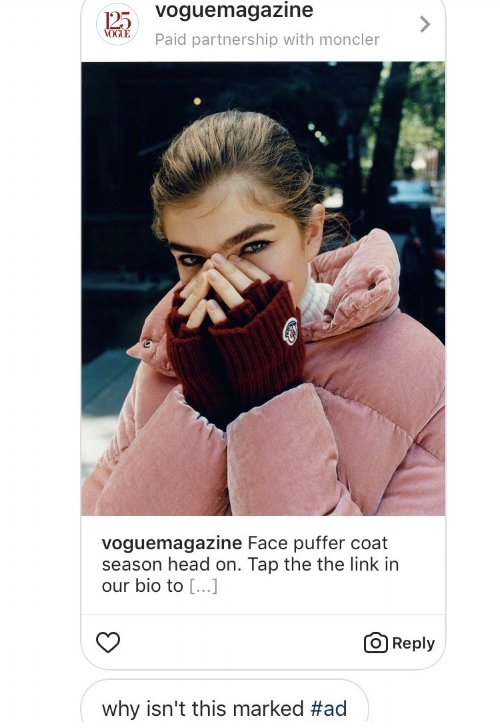
image: @OliviaPalermo Instagram
Instagram is attempting to get one step ahead of the sleeping giant that is the Federal Trade Commission (“FTC”) Act. In light of widespread FTC Act violations on its platform, the Facebook-owned social media app announced that it is in the process of enabling users to add a “paid partnership with” label that will appear above posted photos and videos.
Calling it “a step toward transparency,” the disclosure option is likely a calculated legal move to help the platform escape liability if – or when – the FTC decides to crack down not only on influencers flouting the truth in advertising standards, but on secondarily liable platforms, as well.
Instagram’s move to protect itself through disclosure makes a lot of sense if we consider the evolution of trademark and copyright infringement. Looking to extend the scope of who could potentially be held liable in infringement cases, intellectual property holders have taken to including the deep-pocketed, highly established entities that come into play in the chain of infringements, including intermediaries, such as Google and eBay, in their lawsuits, as well.
This is precisely why Tiffany & Co. named eBay in a trademark counterfeit lawsuit in 2004, in a case that has been widely viewed as a major legal challenge in the United States to Internet companies such as eBay, Google, and others that host services that other people provide, which argued that they should not be held responsible for their users’ trademark violations.
Similarly, in 2009, Gucci filed suit against three credit card processing companies, Durango Merchant Services, Frontline Processing Corporation, and Woodforest National Bank, after successfully suing Laurette Company, the entity responsible for maintaining “thebagaddiction.com” website, selling bags falsely bearing Gucci’s trademarks.
In 2014, Cartier and Chloe’s parent company, Richemont, filed suit against an array of internet service providers, including Virgin Media, BSkyB, EE, TalkTalk and BT. Richemont asked a United Kingdom court to block other websites allegedly selling goods that infringe its trademarks.
Although the outcomes in each of these cases – and others involving allegedly secondarily liable entities – have varied quite a bit, the ruling in favor of eBay against Tiffany & Co. in the Second Circuit Court of Appeals is particularly telling. In eBay’s case, the online marketplace was able to escape liability thanks to its employment of an ever-expanding arsenal of computer-based defenses against infringing and counterfeit goods, including its “notice and takedown” system — its VeRO program.
The court held that in order to escape secondary liability, a party, “when it has reason to suspect that users of its service are infringing a protected mark, may not shield itself from learning of the particular infringing transactions by looking the other way.”

But back to Instagram. With this pattern in mind, it is not completely untenable that the FTC in its fight against undisclosed commercial content, will go after “big fish,” so to speak, like the Kardashians and … Instagram. Moreover, considering that the Instagram platform is hosting the vast majority of undisclosed or improperly disclosed sponsored content, it would also not be a stretch to implicate the platform.
Instagram has not, until very recently, addressed the widespread FTC violations amongst its users. In fact, Instagram still lacks any policy that governs “branded content.” Just this week, Instagram stated that “in the coming months, we’ll also be launching an official policy and enforcement for creators to follow based off Facebook’s current practices,” which require “publishers and influencers to tag the marketer in the post to make it clear that the post is branded content.”
Not only does this arguably stand to speed up the utilization of disclosures by influencers and brands – as the FTC is certainly not taking formal action in any expedited manner; it serves to potentially get Instagram off the hook if it is named in a secondary liability lawsuit or FTC proceeding of the same nature at some point in the future … because there is also a chance, of course, that Instagram, itself, was on the receiving end of a letter from the FTC.
It is, however, absolutely worth noting that the FTC has not specifically stated the Instagram’s new feature is a valid form of disclosure! Instagram’s practices do not – after all – serve to trump the guidelines put forth by the FTC in any way.
Why wouldn’t Instagram’s new feature meet the FTC’s disclosure guidelines? Well, in theory, the size of the text indicating the “paid partnership” is smaller than the text of comments – and it is in a lighter, arguably less visible hue. Moreover, if the caption added in this section is long, it may be cut off.
Still yet, ts indicated in just one example above, Instagram users have been known to miss this new Instagram disclosure, which could prove worrying to the FTC. As such, there is a chance that the FTC will ultimately find that this form of disclosure is not “clear and conspicuous” enough to be a valid disclosure.That is worth keeping in mind, brands and influencers.










